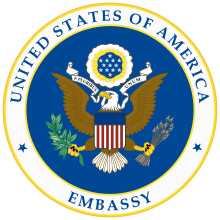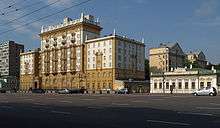Embassy of the United States, Moscow
The Embassy of the United States of America in Moscow is the diplomatic mission of the United States of America in the Russian Federation. The current embassy compound is in the Presnensky District of Moscow. Its New Office Building (NOB) address is: Bolshoy Deviatinsky Pereulok No. 8. The NOB was opened on May 5, 2000. From 1934 to 1953 the embassy was located in the Mokhovaya House, 13 Mokhovaya Street, near the Kremlin. In 1953 the embassy moved into the Existing Office Building (EOB) on Novinskiy Boulevard, which still remains a part of the embassy compound.[1]
| Embassy of the United States, Moscow | |
|---|---|
| Native name Russian: Посольство Соединенных Штатов Америки, Москва (Posol'stvo Soedinennykh Shtatov Ameriki, Moskva) | |
  New embassy as seen from the street | |
| Location | Bolshoy Deviatinsky Pereulok No. 8 Presnensky District, Moscow, Russia |
| Coordinates | 55.755556°N 37.583056°E |
| Ambassador | John Sullivan |
Organization
The embassy consists of the following sections:[2]
- Political Section
- Management Section
- Regional Security Office
- Economic Affairs Section
- Public Affairs Section
- Consular Section
- Environment, Science, Technology, & Health Section
- Law Enforcement Section
In addition, representatives of several U.S. federal agencies work in the embassy.[3]
The embassy oversees two Consulates General in Russia: Vladivostok[4] and Yekaterinburg.[5]
Building

During the period 1953–1976 the Soviets irradiated the US Embassy in Moscow with microwaves in the Moscow Signal incident.[6]
In 1964, covert listening devices were discovered within the US Embassy in Moscow.[7]
On August 26, 1977, a fire erupted on the eighth floor of the embassy building. Although it was extinguished, a large amount of information was lost or stolen. (Several firefighters were in fact KGB personnel charged with removing sensitive material.)[8]
Construction of a new chancery began in 1979. In 1985, the building's columns, which had been built by Soviet workers, were found to be riddled with listening devices, to such an extent that classified information had to be handled in the old embassy. In retaliation, Soviet diplomats were not allowed to occupy their new chancery in Washington, D.C. The standoff was resolved in 1994 when American workers were allowed to partially dismantle and rebuild the chancery with four completely new upper floors. In 2000, the new building was finally opened with classified business confined to the upper floors, while standard consular business is conducted in the insecure lower floors.[9]
On a Russian television program, Igor Korotchenko, editor of a magazine called National Defense and a former specialist in Russia's military command, described the structure of the current embassy building as follows: "The N.S.A. is a global electronic vacuum cleaner, which monitors everything. Look at the top two floors of the new building of the U.S. Embassy—it's a huge antenna, which listens to the Moscow air."[10]
The New York Times reported on November 14, 2017 that Secretary of State Rex Tillerson hired a Russian company with a KGB link to Vladimir Putin to guard the United States Embassy in Moscow.[11][12][13]
Ambassadors
The position of United States Ambassador to Russia, is currently held by John Sullivan.
See also
- Diplomatic missions in Russia
- Diplomatic missions of the United States
- Russia–United States relations
- Soviet Union–United States relations
- Embassy of Russia in Washington, D.C.
References
- "U.S. Embassy Moscow". Retrieved 1 May 2019.
- "Key Officers, Sections & Offices". Retrieved 1 May 2019.
- "Key Officers, Sections & Offices". Retrieved 1 May 2019.
- "U.S. Consulate General in Vladivostok". Retrieved 1 May 2019.
- "U.S. Consulate General in Yekaterinburg". Retrieved 1 May 2019.
- Carpenter, David O. (2015). "The microwave syndrome or electro-hypersensitivity: historical background". Reviews on Environmental Health. 30 (4): 217–222. doi:10.1515/reveh-2015-0016. ISSN 2191-0308. PMID 26556835.
- "ESTIMATE OF DAMAGE TO U.S. FOREIGN POLICY INTERESTS". Archived from the original on 16 March 2016. Retrieved 2 April 2017.CS1 maint: BOT: original-url status unknown (link)
- "The Embassy Moscow Fire of 1977". Association for Diplomatic Studies and Training. Retrieved March 11, 2017.
- Lally, Kathy (2000-07-08). "U.S. Finally Opens Moscow Embassy / Building was delayed 15 years after Russians riddled it with bugs". SFGate. San Francisco: Hearst Communications. Retrieved 27 October 2015.
- Barry, Ellen (June 28, 2013). "While N.S.A. Leaker Stays in Hiding, Russian TV Builds a Pedestal for Him". The New York Times. pp. 1–2. Retrieved June 30, 2013.
- Higgins, Andrew (2017-11-14). "U.S. Hires Company With K.G.B. Link to Guard Moscow Embassy". The New York Times. ISSN 0362-4331. Retrieved 2017-11-15.
- Delk, Josh (2017-11-14). "State Department hires security company with KGB ties". The Hill. Retrieved 2017-11-15.
- "US to use Russia firm founded by KGB spy". BBC News. 2017-11-10. Retrieved 2017-11-15.
External links
| Wikimedia Commons has media related to Embassy of the United States in Moscow. |
